L-Shaped Slot-Loaded Stepped-Impedance Microstrip Structure UWB Antenna
Abstract
1. Introduction
2. Antenna Structure
3. Simulation Design Analysis
4. Results
5. Conclusions
Author Contributions
Funding
Conflicts of Interest
References
- Sanz-lzquierdo, B.; Young, P.R.; Bai, Q.; Batchelor, J.C. Compact UWB Monopole for Multilayer Applications. Electron. Lett. 2006, 42, 5–9. [Google Scholar] [CrossRef]
- Bourdel, S.; Bachelet, Y.; Gaubert, J.; Vauche, R.; Fourquin, O.; Dehaese, N.; Barthelemy, H. A 9-pJ/Pulse 1.42-Vpp OOK CMOS UWB Pulse Generator for the 3.1–10.6-GHz FCC Band. IEEE Trans. Microwave Theory Technol. 2009, 58, 65–73. [Google Scholar] [CrossRef]
- Ruengwaree, A.; Ghose, A.; Kompa, G. A Novel UWB Rugby-Ball Antenna for Near-range Microwave Radar System. IEEE Trans. Microwave Theory Tech. 2006, 54, 2774–2779. [Google Scholar] [CrossRef]
- Tan, A.E.C.; Chia, M.Y.W. Measuring Human Body Impulse Response Using UWB Radar. Electron. Lett. 2005, 41, 1193–1194. [Google Scholar] [CrossRef]
- Xu, R.; Jin, Y.; Nguyen, C. Power-efficient switching-based CMOS UWB Transmitters for UWB Communications and Radar Systems. IEEE Trans. Microwave Theory Tech. 2006, 54, 3271–3277. [Google Scholar]
- Siriwongpairat, W.P.; Su, W.F.; Olfat, M.; Liu, K.R. Multiband-OFDM MIMO Coding Framework for UWB Communication Systems. IEEE Trans. Signal Process. 2006, 54, 214–224. [Google Scholar] [CrossRef]
- Ma, Z.H.; Jiang, Y.F. High-Density 3D Printable Chipless RFID Tag with Structure of Passive Slot Rings. Sensors 2019, 19, 2535. [Google Scholar] [CrossRef]
- Vito, G.D.; Stracca, G. Further comments on the design of log-periodic dipole Antennas. IEEE Trans. Antennas Propag. 1974, 22, 714–718. [Google Scholar] [CrossRef]
- Zhong, Y.W.; Yang, G.M.; Mo, J.Y.; Zheng, L. Compact circularly polarized archimedean spiral antenna for ultrawideband communication applications. IEEE Antennas Wirel. Propag. Lett. 2016, 16, 129–132. [Google Scholar] [CrossRef]
- Liang, J.; Chiau, C.C.; Chen, X.; Parini, C.G. Analysis and Design of UWB Disc Monopole Antennas. In Ultra Wideband Communications Technologies and System Design; IET: London, UK, 2004; pp. 103–106. [Google Scholar]
- Ammann, M.J.; Zhi, N.C. Wideband monopole antennas for multi-band wireless systems. IEEE Antennas Propag. Mag. 2003, 45, 146–150. [Google Scholar] [CrossRef]
- Chen, Z.N.; Chia, M.Y.W.; Ammann, M.J. Optimization and comparison of broadband monopoles. IEE Proc. Microw. Antennas Propag. 2003, 150, 429–435. [Google Scholar] [CrossRef]
- Liu, J.; Geng, J.; Wang, K.; Zhu, W. A low-profile, directional, ultrawideband antenna. IEEE Antennas Wirel. Propag. Lett. 2019, 18, 255–259. [Google Scholar] [CrossRef]
- Liang, J.; Chiau, C.C.; Chen, X.; Parini, C.G. Study of a printed circular disc monopole antenna for UWB systems. IEEE Trans. Antennas Propag. 2005, 53, 3500–3504. [Google Scholar] [CrossRef]
- Wu, Q.; Jin, R.H.; Geng, J.P.; Ding, M. Compact CPW-fed quasi-circular monopole with very wide bandwidth. Electron. Lett. 2007, 43, 69–70. [Google Scholar] [CrossRef]
- Yassin, M.E.; Mohamed, H.A.; Abdallah, E.A.F.; EI-Hennawy, H.S. Circularly polarized wideband-to-narrowband switchable Antenna. IEEE Access 2019, 7, 36010–36018. [Google Scholar] [CrossRef]
- Nazli, H.; Bicak, E.; Turetken, B.; Sezgin, M. An improved design of planar elliptical dipole Antenna for UWB applications. IEEE Antennas Wirel. Propag. Lett. 2010, 9, 264–267. [Google Scholar] [CrossRef]
- Low, Z.N.; Cheong, J.H.; Law, C.L. Low-cost PCB Antenna for UWB applications. IEEE Antennas Wirel. Propag. Lett. 2005, 4, 237–239. [Google Scholar] [CrossRef]
- Gopikrishna, M.; Krishna, D.D.; Aanandan, C.K.; Mohanan, P.; Vasudevan, K. Compact linear tapered slot Antenna for UWB applications. Electron. Lett. 2008, 44, 1174–1175. [Google Scholar] [CrossRef]
- Yang, Y.; Zhao, Z.; Ding, X.; Nie, Z.; Liu, Q.H. Compact UWB slot Antenna utilizing traveling-wave mode based on slotline transitions. IEEE Trans. Antennas Propag. 2019, 67, 140–150. [Google Scholar] [CrossRef]
- Hussain, R.; Sharawi, M.S.; Shamim, A. An integrated four-element slot-based MIMO and a UWB sensing Antenna system for CR platforms. IEEE Trans. Antennas Propag. 2018, 66, 978–983. [Google Scholar] [CrossRef]
- Shirazi, M.; Li, T.; Huang, J.; Gong, X. A reconfigurable dual-polarization slot-ring Antenna element with wide bandwidth for array applications. IEEE Trans. Antennas Propag. 2018, 66, 5943–5954. [Google Scholar] [CrossRef]
- Qu, S.W.; Li, J.L.; Xue, Q. Broadband microstrip-line-fed wide slot Antenna with improved patterns. Electron. Lett. 2006, 42, 893–894. [Google Scholar] [CrossRef]
- Paul, P.M.; Kandasamy, K.; Sharawi, M.S.; Majumder, B. Dispersion-engineered transmission line loaded slot Antenna for UWB applications. IEEE Antennas Wirel. Propag. Lett. 2019, 18, 323–327. [Google Scholar] [CrossRef]
- Pourahmadazar, J.; Ghobadi, C.; Nourinia, J.; Felegari, N.; Shirzad, H. Broadband CPW-fed circularly polarized square slot Antenna with inverted-L strips for UWB applications. IEEE Antennas Wirel. Propag. Lett. 2011, 10, 369–372. [Google Scholar] [CrossRef]
- Sadat, S.; Fardis, M.; Geran, F.; Dadashzadeh, G.; Hojjat, N.; Roshandel, M. A compact microstrip square-ring slot Antenna for UWB applications. In Proceedings of the 2006 IEEE Antennas and Propagation Society International Symposium, Albuquerque, NM, USA, 9–14 July 2006; pp. 4629–4632. [Google Scholar]
- Lee, C.H.; Hsu, C.I.; Jhuang, H.K. Design of a New Tri-Band Microstrip BPF Using Combined Quarter-Wavelength SIRs. IEEE Microw. Wirel. Compon. Lett. 2006, 16, 594–596. [Google Scholar] [CrossRef]
- Hsu, C.; Kuo, J. Design of cross-coupled quarter-wave SIR filters with plural transmission zeros. In Proceedings of the 2006 IEEE MTT-S International Microwave Symposium Digest, San Francisco, CA, USA, 11–16 June 2006; pp. 1205–1208. [Google Scholar]
- Lerdwanittip, R.; Namsang, A.; Akkaraekthalin, P. Bandpass filters using T-shape stepped impedance resonators for wide harmonics suppression and their application for a diplexer. J. Semicond. Technol. Sci. 2011, 11, 65–72. [Google Scholar] [CrossRef]
- Zarghooni, B.; Denidni, T.A. New compact metamaterial unit-cell using SIR technique. IEEE Microw. Wirel. Compon. Lett. 2014, 24, 315–317. [Google Scholar] [CrossRef]
- Makimoto, M.; Yamashita, S. Bandpass filters using parallel coupled stripline stepped impedance resonators. IEEE Trans. Microw. Theory Tech. 1980, 28, 1413–1417. [Google Scholar] [CrossRef]
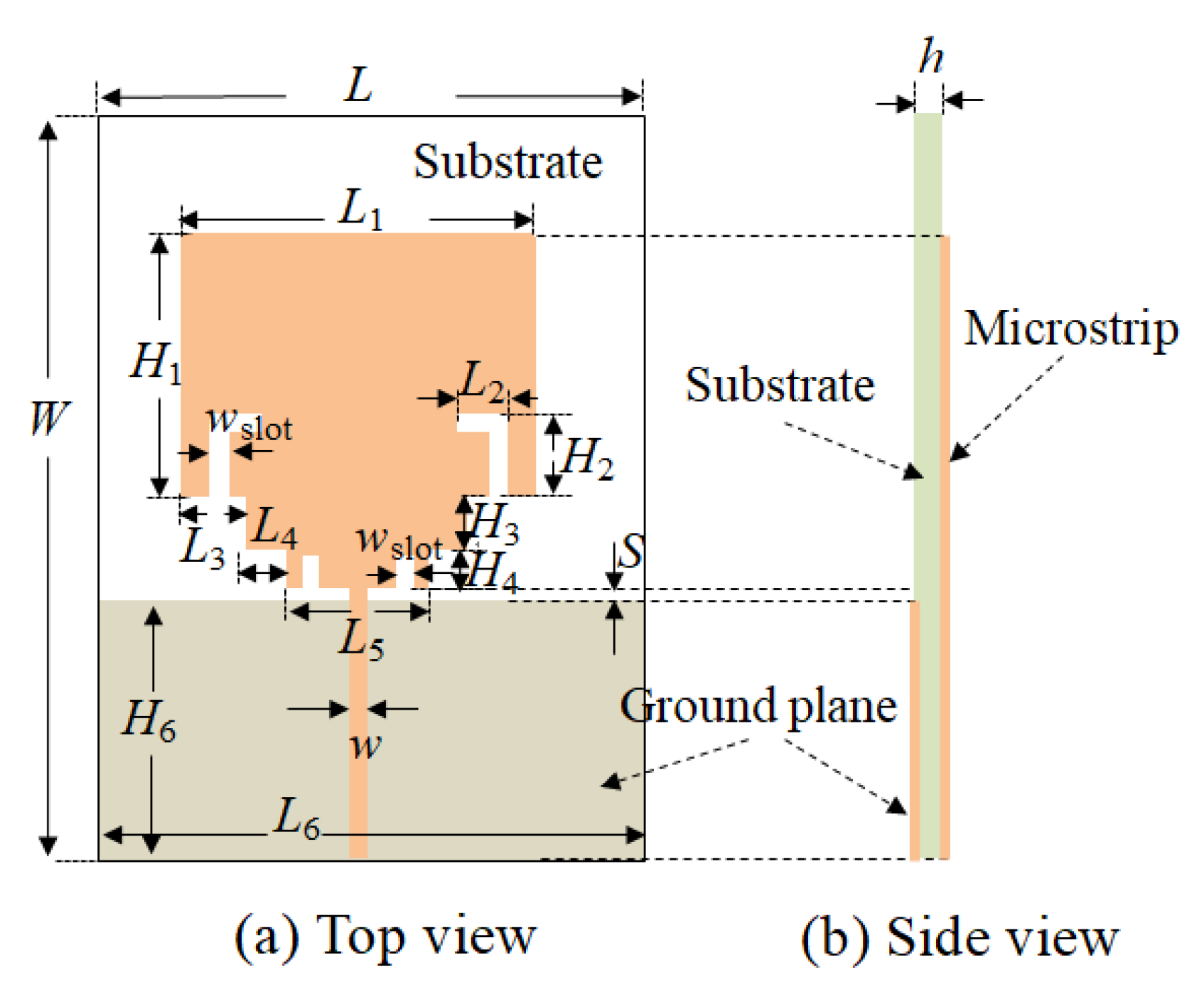
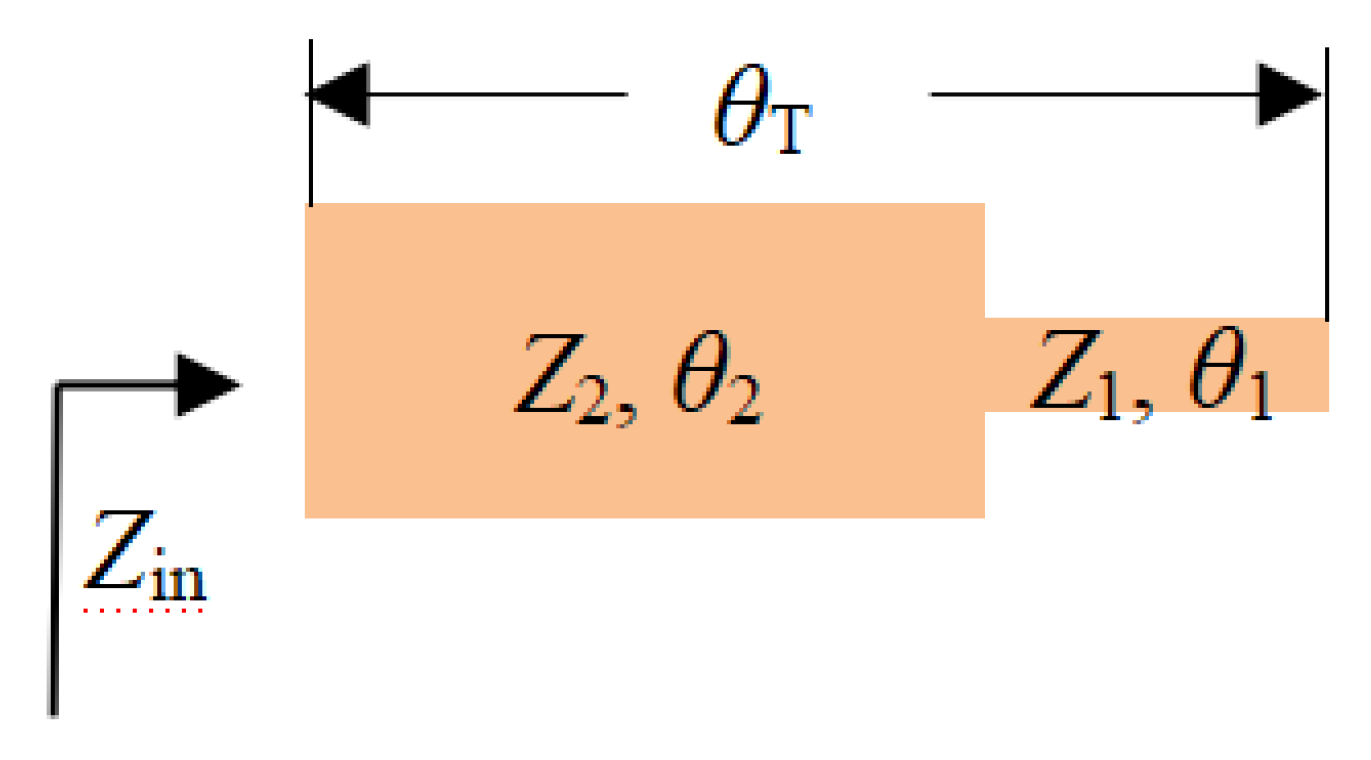

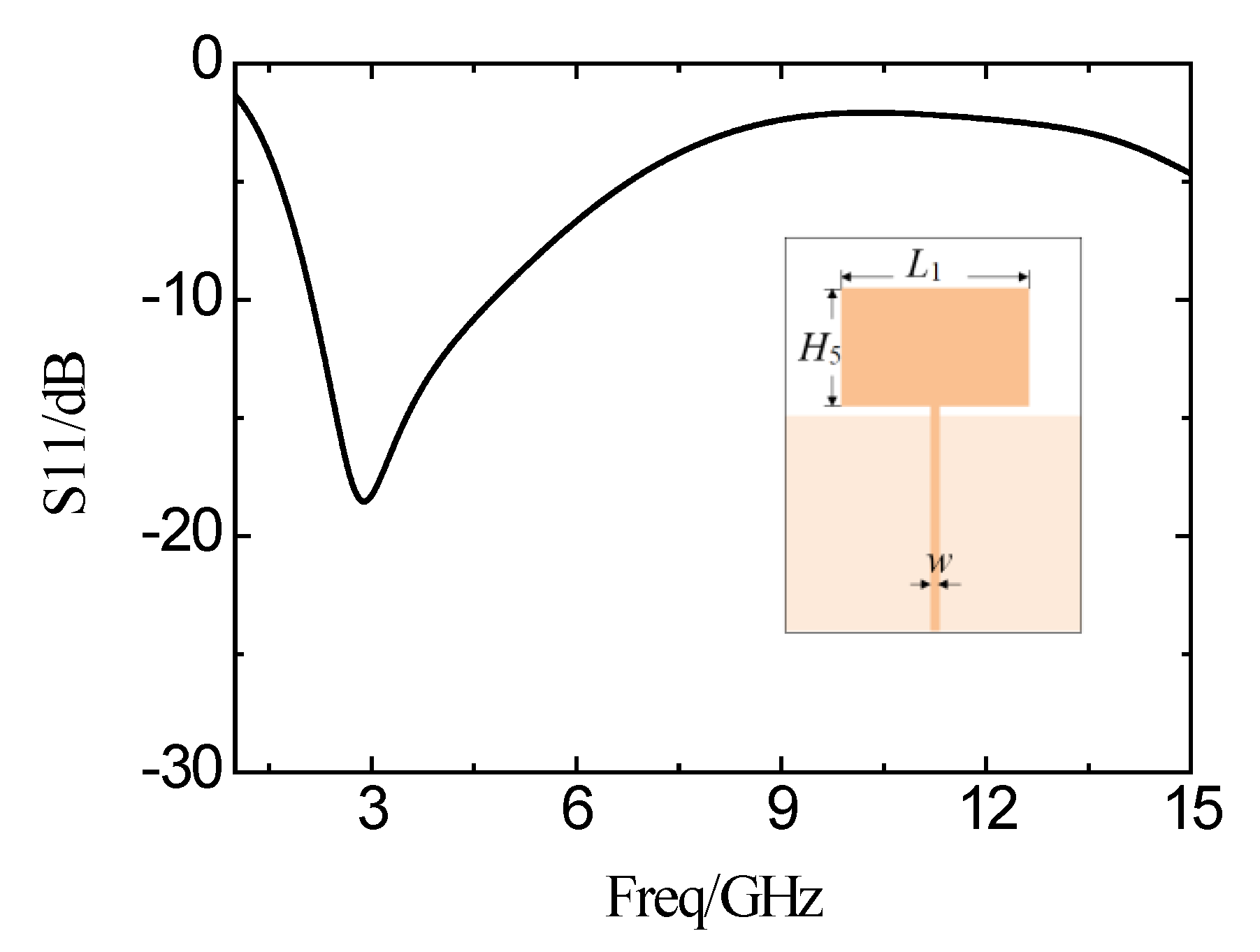
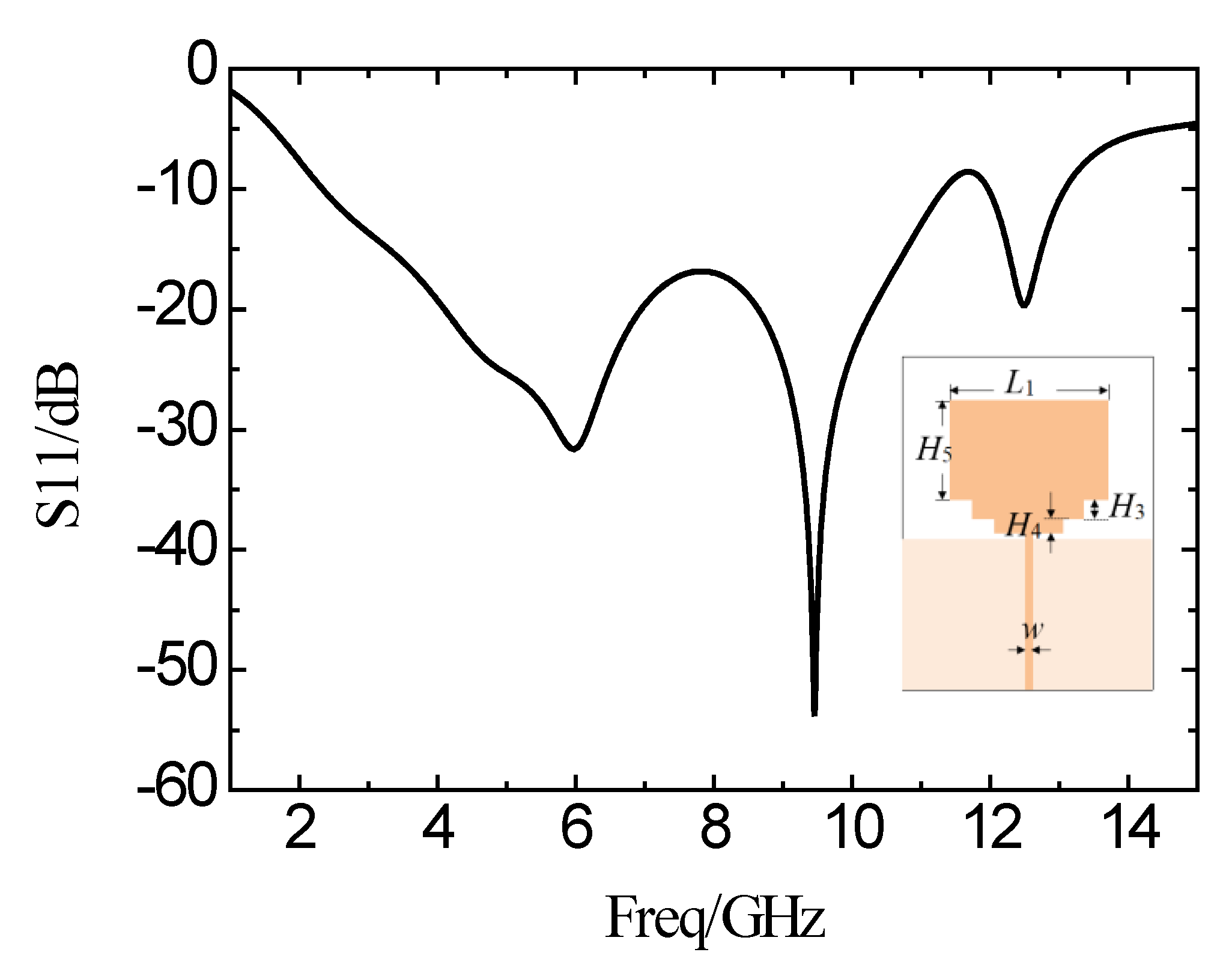


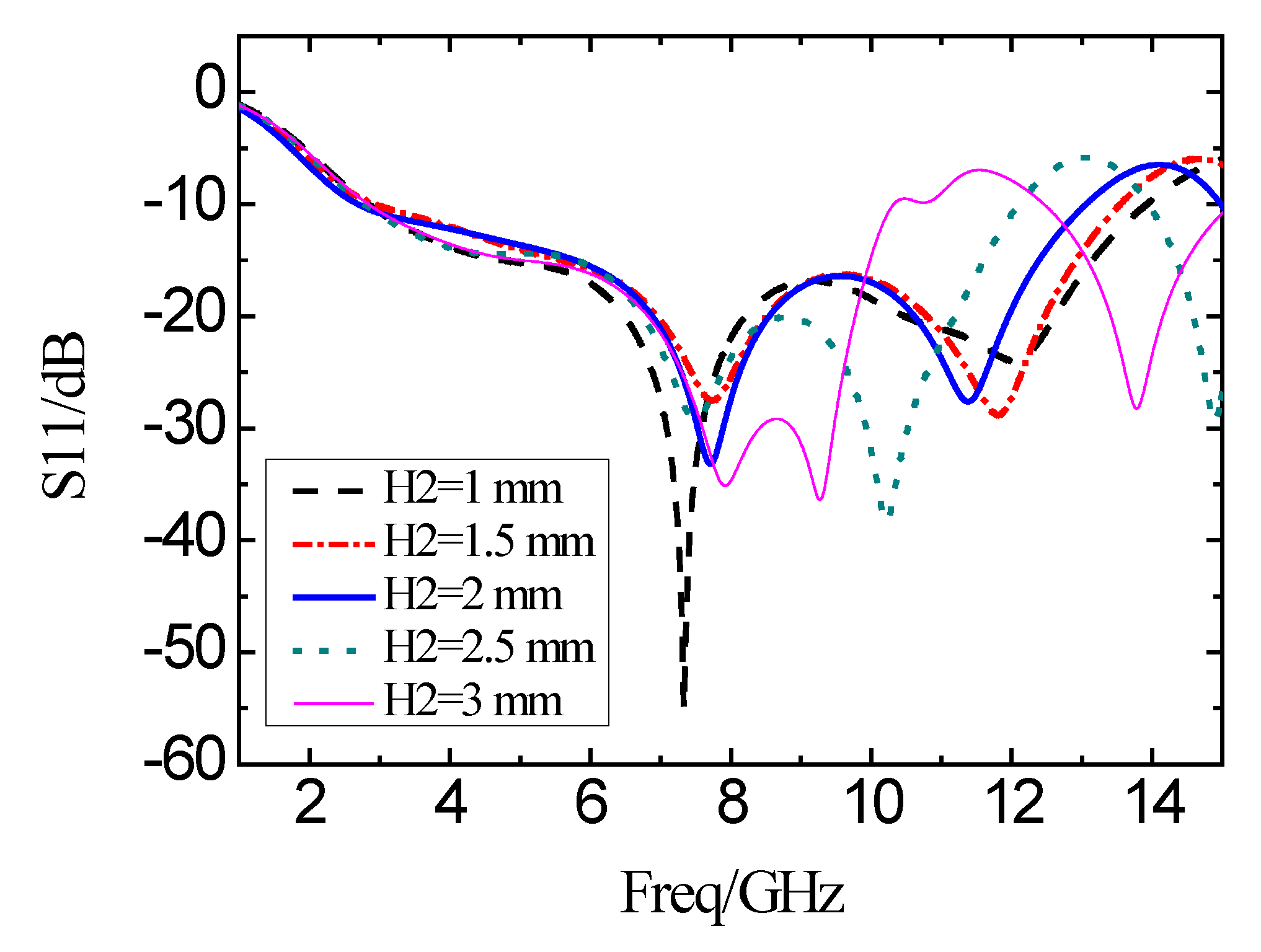

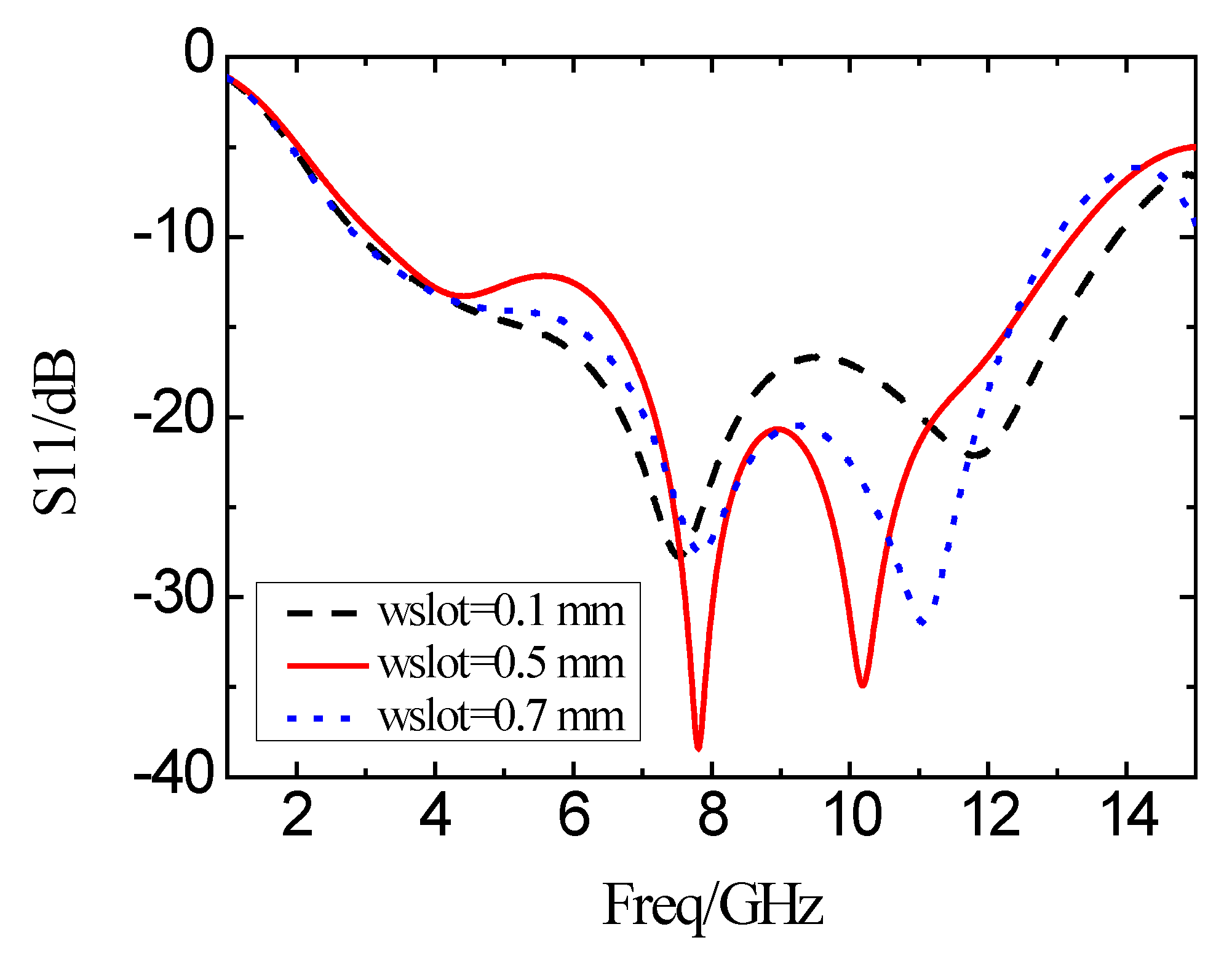
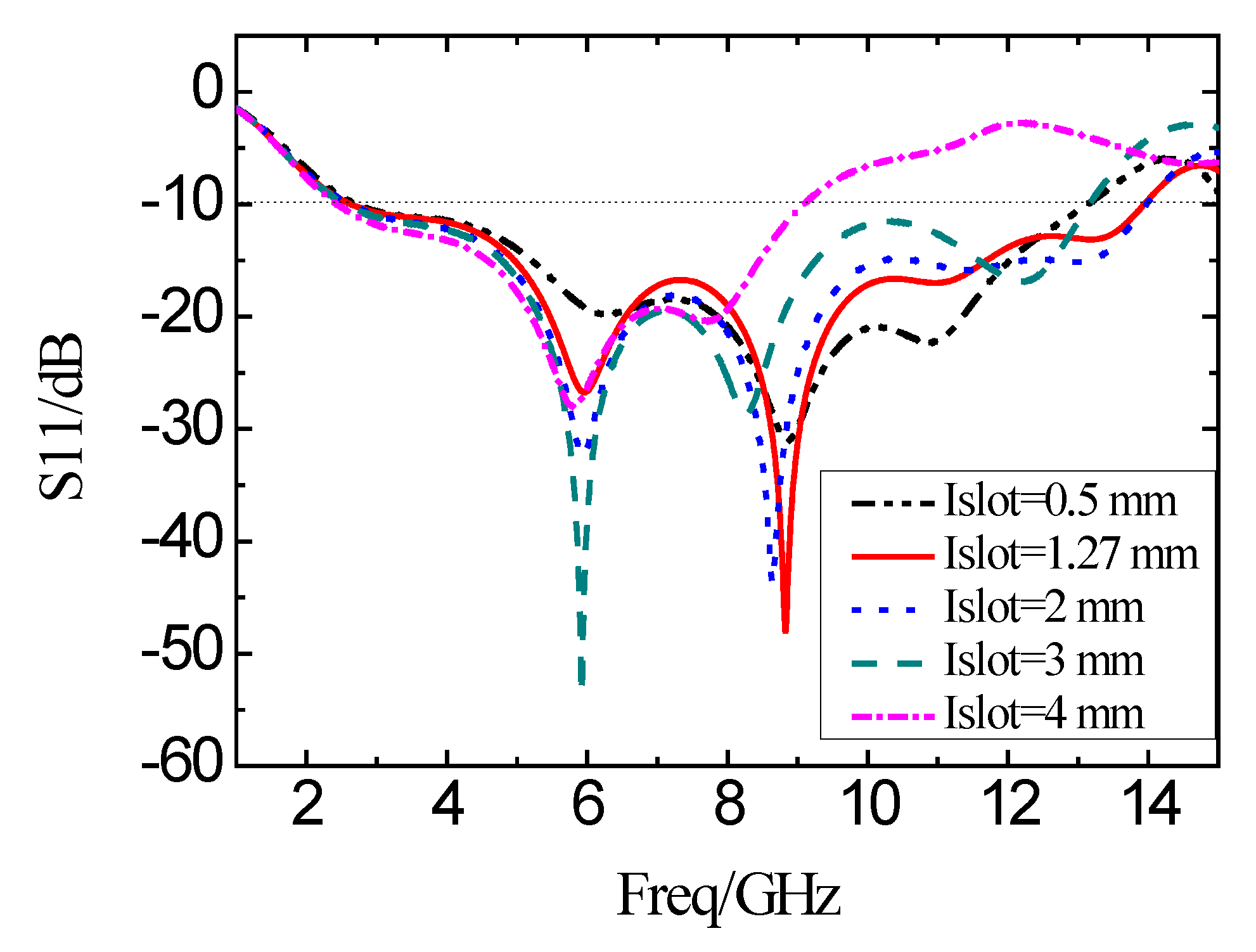
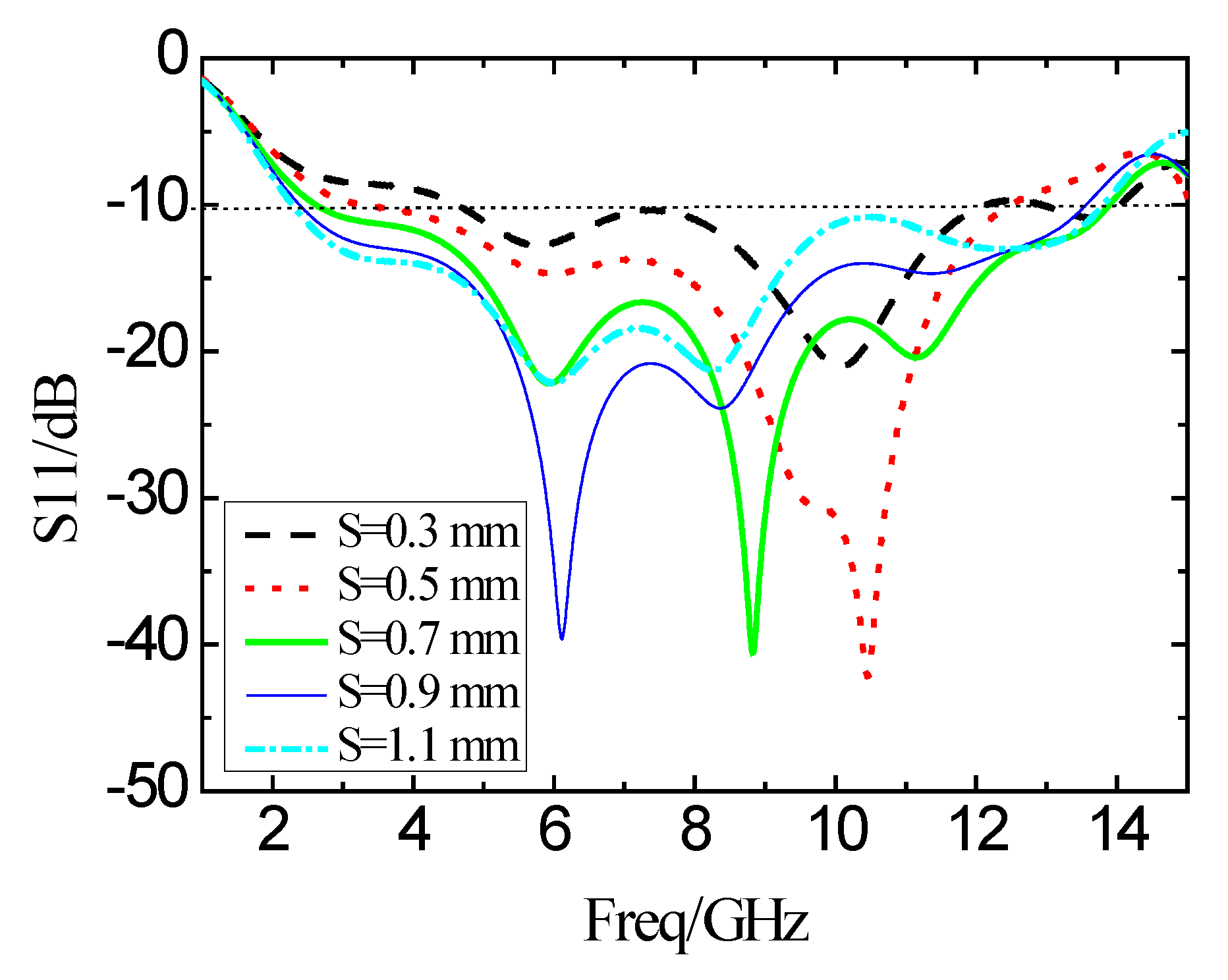
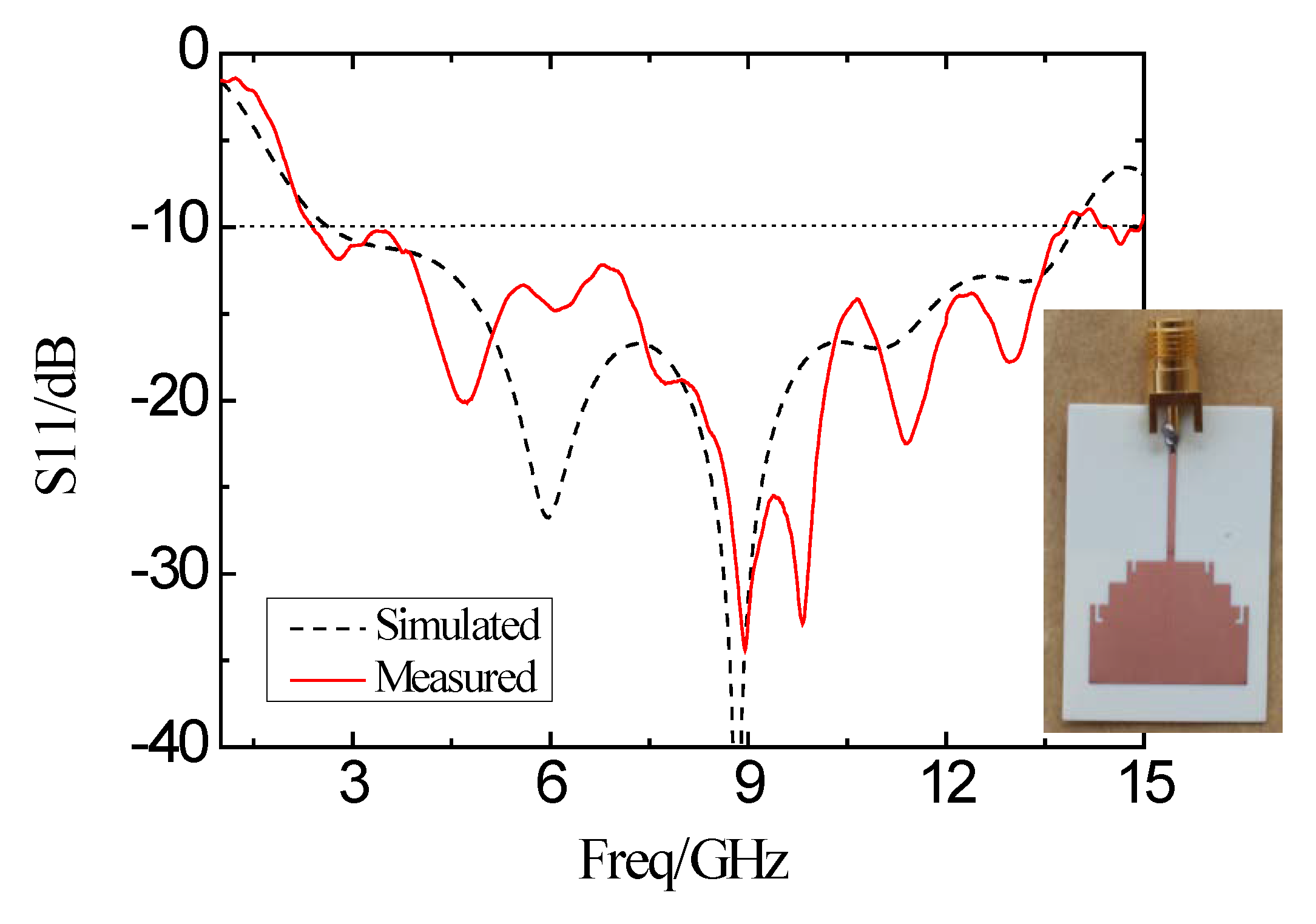
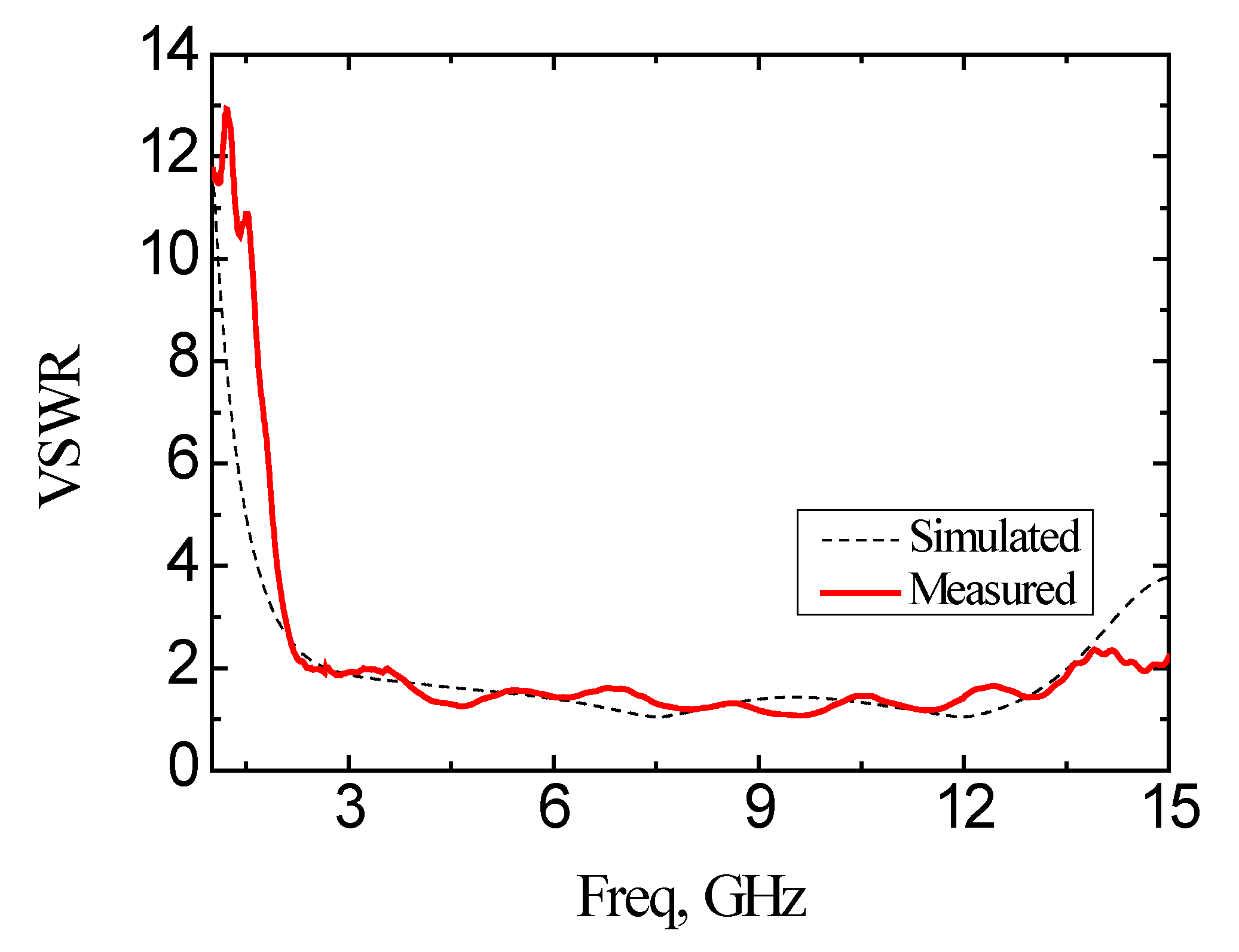

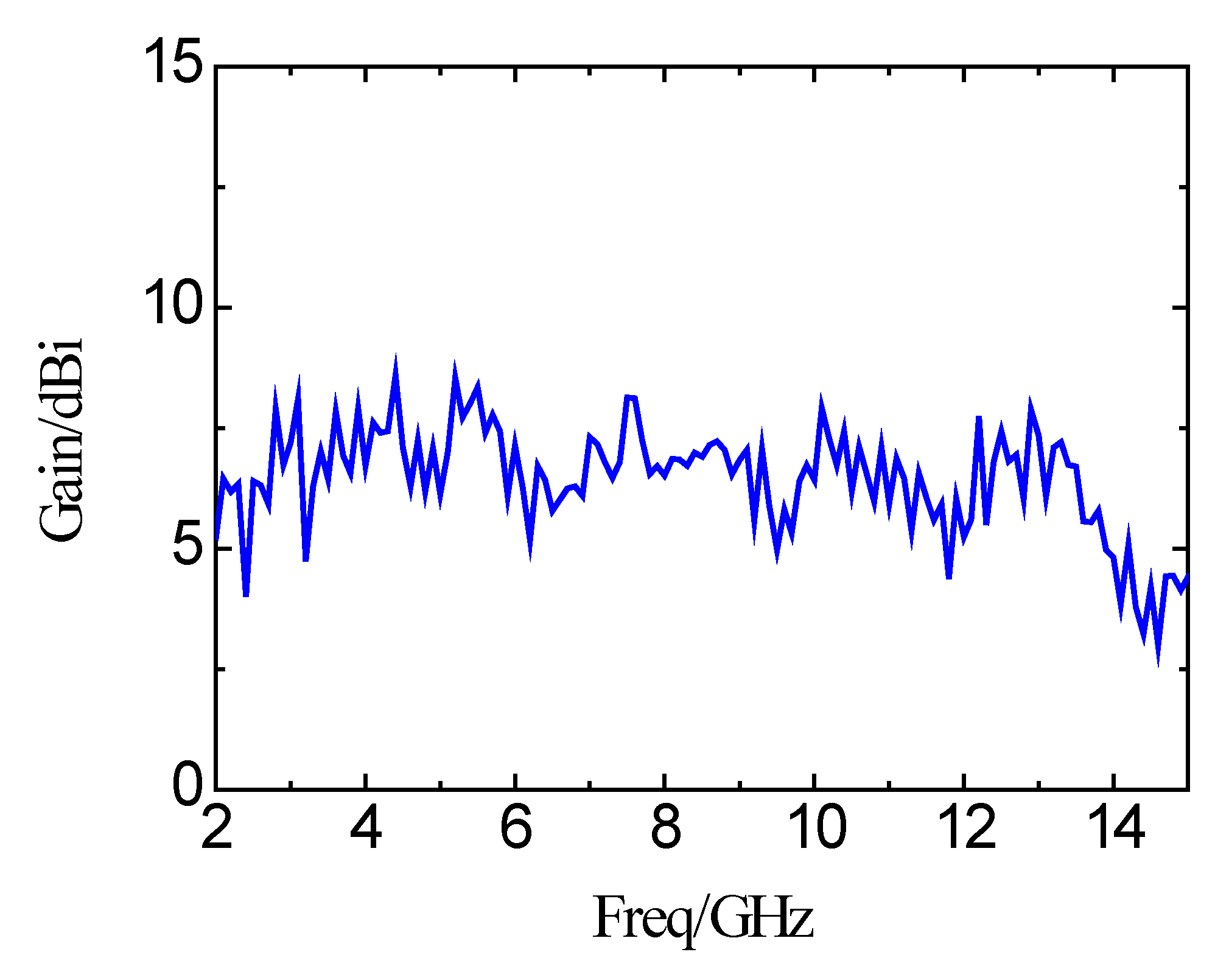
| Parameter | Value (mm) | Parameter | Value (mm) |
|---|---|---|---|
| L1 | 18 | H1 | 11 |
| L2 | 1 | H2 | 2 |
| L3 | 1.465 | H3 | 2.5 |
| L4 | 4 | H4 | 2.5 |
| L5 | 11.07 | wslot | 0.5 |
| L6 | 23 | H6 | 16.8 |
| w | 1.07 | h | 0.508 |
| Islot | 1.27 | S | 0.7 |
| W | 36 | L | 23 |
| References | Type | Dielectric Constant | Size (mm2) | Bandwidth (GHz) | Peak Gain (dBi) | Gain Variation (dB) |
|---|---|---|---|---|---|---|
| [14] | Disc monopole | 4.7 | 42 × 50 | 2.78–9.78 | - | - |
| [15] | Quasi-circular | 2.65 | 40 × 30 | 2.55–18.5 | - | - |
| [16] | Microstrip | 3.38 | 45 × 50 | 3–11.57 | 4.2–6.91 | 2.71 |
| [17] | Dipole | 2.2 | 106 × 85 | 1.1–11 | ±5 | 10 |
| [18] | Reconfigurable Slot-ring array | 2.2 | 80 × 80 | 1.8–3.7 and 4.5–8.23 | 2.4–3.1 | 0.7 |
| [19] | Annular slot | 3.48 | 120 × 60 | 0.75–7.65 | 0.5–3.2 | 2.7 |
| [20] | Slot | 4.4 | 25 × 30 | 2.9–11.8 | 2–6 | 4 |
| [21] | Slot | 4.4 | 30 × 30 | 4–10 | 0–4.8 | 4.8 |
| [22] | Tapered slot | 4.4 | 30 × 13.5 | 2.95–14 | 1.7–4.1 | 2.4 |
| [23] | Slot | 2.33 | 52 × 62 | 2.1–11.5 | 3.5–7 | 3.5 |
| [24] | Square slot | 2.2 | 50 × 50 | 2.1–11.5 | 3.8–5.7 | 1.9 |
| [25] | Square slot | 4.4 | 60 × 60 | 2.8–13 | 3–4.13 | 1.13 |
| [26] | Square-ring slot | 3.4 | 120 × 100 | 3–11 | 2–6 | 2 |
| This paper | Slot | 3.66 | 36 × 23 | 2.39–13.78 | 4–8.54 | 4.54 |
© 2020 by the authors. Licensee MDPI, Basel, Switzerland. This article is an open access article distributed under the terms and conditions of the Creative Commons Attribution (CC BY) license (http://creativecommons.org/licenses/by/4.0/).
Share and Cite
Ma, Z.H.; Jiang, Y.F. L-Shaped Slot-Loaded Stepped-Impedance Microstrip Structure UWB Antenna. Micromachines 2020, 11, 828. https://doi.org/10.3390/mi11090828
Ma ZH, Jiang YF. L-Shaped Slot-Loaded Stepped-Impedance Microstrip Structure UWB Antenna. Micromachines. 2020; 11(9):828. https://doi.org/10.3390/mi11090828
Chicago/Turabian StyleMa, Zhong Hua, and Yan Feng Jiang. 2020. "L-Shaped Slot-Loaded Stepped-Impedance Microstrip Structure UWB Antenna" Micromachines 11, no. 9: 828. https://doi.org/10.3390/mi11090828
APA StyleMa, Z. H., & Jiang, Y. F. (2020). L-Shaped Slot-Loaded Stepped-Impedance Microstrip Structure UWB Antenna. Micromachines, 11(9), 828. https://doi.org/10.3390/mi11090828






